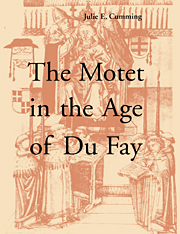Book contents
- Frontmatter
- Contents
- List of tables
- List of musical examples
- Acknowledgments
- Notes to the reader
- Introduction
- Part I Models and methods
- Part II Motets in the early fifteenth century: the case of Bologna Q15
- 4 The motet section of Bologna Q15 and its ramifying roots
- 5 A new hybrid subgenre: the cut-circle motet
- 6 Other new hybrid subgenres
- 7 The motet in the early fifteenth century: evolution and interpretation
- Part III Motets in the mid-fifteenth century: the case of the Trent Codices
- Conclusion
- Appendix: Widely disseminated motets
- Notes
- Bibliography of books and articles
- Modern editions of music
- Sources and sigla
- Notes on the index of works
- Abbreviations for subgenre identifications
- Index of works
- General index
7 - The motet in the early fifteenth century: evolution and interpretation
Published online by Cambridge University Press: 22 September 2009
- Frontmatter
- Contents
- List of tables
- List of musical examples
- Acknowledgments
- Notes to the reader
- Introduction
- Part I Models and methods
- Part II Motets in the early fifteenth century: the case of Bologna Q15
- 4 The motet section of Bologna Q15 and its ramifying roots
- 5 A new hybrid subgenre: the cut-circle motet
- 6 Other new hybrid subgenres
- 7 The motet in the early fifteenth century: evolution and interpretation
- Part III Motets in the mid-fifteenth century: the case of the Trent Codices
- Conclusion
- Appendix: Widely disseminated motets
- Notes
- Bibliography of books and articles
- Modern editions of music
- Sources and sigla
- Notes on the index of works
- Abbreviations for subgenre identifications
- Index of works
- General index
Summary
The scribe of Bologna Q15 determined which pieces should go in the motet section. As we have seen, many different kinds of piece were considered by the scribe to be motets, and en masse they share few characteristics. By identifying the different subgenres, however, we have established kinds of motet that can be described and identified by means of characteristic features. Knowledge of the various subgenres thus allows us to recognize motets in other sources as well, even those without distinct motet sections. Comparison of the motets in Bologna Q15 with those found in other manuscripts of the period gives us a key to the whole motet repertory of the early fifteenth century. The comparison will also allow us to investigate the evolutionary success of the different subgenres. A subgenre (like a variety or species) can die out or it can survive and continue to evolve. Its fate is determined by the fates of the individual works that make up the subgenre: if they reproduce the subgenre will survive, if not it will die out. Reproduction, in the case of motets, takes two forms: a work can be copied in multiple manuscripts, or it can give rise to new works resembling it in various ways.
The first kind of reproduction (manuscript copies) is best observed in relation to individual works rather than subgenres. The second kind of reproduction (leading to production of new works) can be recognized by the continued presence of new examples of a subgenre in the repertory.
- Type
- Chapter
- Information
- The Motet in the Age of Du Fay , pp. 147 - 164Publisher: Cambridge University PressPrint publication year: 1999



